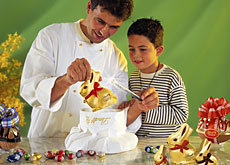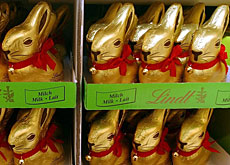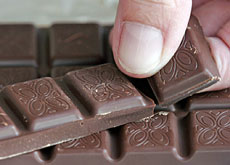Maître chocolatier makes chocolate magic

The Easter gold bunny is synonymous with its maker Lindt & Sprüngli but the company's maîtres chocolatiers also make other chocolate treats.
swissinfo went to the firm’s headquarters on Lake Zurich to watch one of them, Urs Liechti, in action.
Since Lindt invented the conching method in the 19th century to make silky smooth chocolate that melts in the mouth, it has built up a strong reputation for quality.
Apart from the bunnies, its portfolio includes Lindor chocolate balls, the Excellence dark chocolate range and many other specialties.
Liechti has the enviable job of being the head of product development at Lindt Switzerland. He and his team spend all day coming up with tasty chocolate combinations.
In his workshop – from which delicious smells emanate – Maîtres Chocolatiers are developing the next set of light and fruity Chocoletti for spring 2008.
Liechti explains that they make between 100-300 samples by hand, carefully noting down all the recipes, to ensure that they get the chocolates just right.
“I eat between 100 and 150g of chocolate a day,” says Liechti, who, nonetheless, looks very trim.
Liechti says creating boxes of pralines is the most challenging, as each chocolate has to be different but the combination of design and taste must also be perfectly balanced. Most recently the team has been reworking the successful Petits Desserts range, due for relaunch this autumn.
Boxes of chocolates
It takes up to two-and-a-half years to develop a box of assorted chocolates. In the case of Petits Desserts, the marketing department observed a trend towards home cooking and grandma-style recipes. The next step was to convert this into chocolate.
The team tried literally hundreds of recipes to see which ones would be best in chocolate form. Not all attempts, however, were successful.
“One we tried was carrot cake, that’s really Swiss, but the question was how do you get carrot into the chocolate, it’s almost impossible thing. But we actually did it,” Liechti told swissinfo.
The team could not use fresh carrots to make a marzipan because they would go mouldy, so they used dried carrot instead, combining it with roasted hazelnuts and almonds.
“It tasted like a good carrot cake surrounded with milk chocolate, but the marketing department was not very happy, they liked the recipe for Switzerland but they were thinking of launching the chocolates internationally,” explained Liechti.
“They worried that other countries might think carrot cake was for bunnies but not for chocolates.”
Once the developed product has been tested on customer panels, the team has to ensure that it can be produced industrially, while still keeping its homemade feel.
Dark chocolate
Liechti also developed the successful Excellence range of dark chocolate tablets.
The health benefits of high-cocoa percentages – Lindt’s ranges from 55 to 99 per cent – have been widely publicised.
However, Liechti is convinced that dark chocolate is simply becoming trendier – rather like fine wine or coffee.
“You just nibble small pieces, like sipping espresso – take a break, five minutes, sit down, relax, and let it melt on your tongue and then you can enjoy all the flavours.”
A rather unusual variant is chilli dark chocolate, whose balance of sweetness and kick has been a great hit among consumers since its launch last November.
Dark chocolate is even making inroads into the more traditionally sweet-toothed and milk- chocolate-loving Germany and Anglo-Saxon nations. It is also highly popular in Japan.
Catering for regional tastes is another one of Lindt’s jobs, which is why it has eight production and development facilities worldwide.
This means that you can buy mint Lindor balls in the United States, but not in Switzerland, where people favour nut combinations.
As for Liechti, he never tires of chocolate and even has a piece on his days off.
“I’m the luckiest guy in the world,” he says of his job.
swissinfo, Isobel Leybold-Johnson in Kilchberg
Chocolate consumption per capita:
1. Switzerland (2006): 11.9 kg
2. Belgium (2004): 9.5 kg
3. Germany (2004): 11.1 kg
4. Austria (2004): 10.1 kg
5. Britain (2004) 9.4 kg
10. US (2004): 5.3 kg
16. Japan (2004) 2.2 kg
Lindt & Sprüngli started out in 1845 as a small Zurich confectionery Sprüngli & Son. In 1899 it acquired the Bern-based Rodolphe Lindt company.
Lindt was the inventor of the conching method, which ensures that chocolate melts in the mouth. It completely changed the modern chocolate making process.
Lindt currently has eight production sites worldwide and is present all over the world. Lindt also owns Italy’s Caffarel and the San Francisco-based brand, Ghirardelli.
It employs more than 7,000 people and in 2006 net sales reached SFr2.6 billion ($2.1 billion).
The gold bunny was born in 1952. It is said that a small boy was entranced by a rabbit in his garden one morning in March. But he was distraught after it hopped away into the bushes.
His father, a maître chocolatier at Lindt, comforted him by promising to make him a chocolate bunny. He made one out of milk chocolate, covered it in gold foil and added a red ribbon with a bell, so that the boy could easily find it.
The gold bunny has since become an Easter institution. It is sold in a range of sizes and in dark and white chocolate in more than 50 countries, even those without an Easter tradition.

In compliance with the JTI standards
More: SWI swissinfo.ch certified by the Journalism Trust Initiative



You can find an overview of ongoing debates with our journalists here. Please join us!
If you want to start a conversation about a topic raised in this article or want to report factual errors, email us at english@swissinfo.ch.